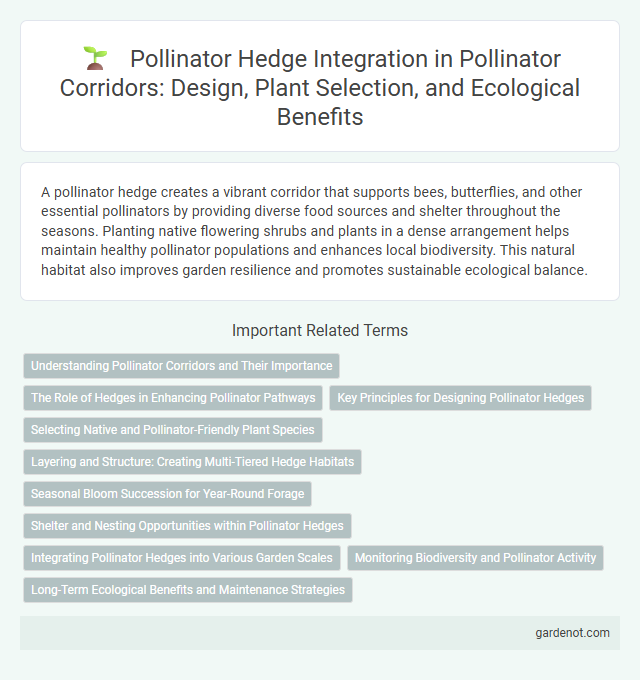A pollinator hedge creates a vibrant corridor that supports bees, butterflies, and other essential pollinators by providing diverse food sources and shelter throughout the seasons. Planting native flowering shrubs and plants in a dense arrangement helps maintain healthy pollinator populations and enhances local biodiversity. This natural habitat also improves garden resilience and promotes sustainable ecological balance.
Understanding Pollinator Corridors and Their Importance
Pollinator hedges serve as critical components of pollinator corridors by providing continuous floral resources and habitat connectivity essential for supporting diverse pollinator species. These hedges enhance biodiversity, promote ecosystem resilience, and improve crop pollination by facilitating safe movement routes for bees, butterflies, and other pollinators. Establishing well-planned pollinator hedges contributes significantly to sustaining pollinator populations amid habitat fragmentation and environmental stressors.
The Role of Hedges in Enhancing Pollinator Pathways
Pollinator hedges play a critical role in enhancing pollinator pathways by providing continuous, nutrient-rich habitats that support diverse pollinator species, including bees, butterflies, and hoverflies. These hedges facilitate safe movement across fragmented landscapes, ensuring pollinators can access a variety of floral resources essential for feeding and breeding. Establishing and maintaining pollinator hedges significantly contributes to biodiversity conservation and promotes ecosystem resilience in agricultural and urban environments.
Key Principles for Designing Pollinator Hedges
Pollinator hedges should be designed with diverse, native flowering plants that provide continuous nectar and pollen from early spring to late fall, supporting a wide range of pollinators including bees, butterflies, and hoverflies. Incorporating structural variety with layers of shrubs, grasses, and wildflowers enhances habitat complexity and shelter, increasing pollinator abundance and biodiversity. Strategic placement along natural corridors and near agricultural fields maximizes connectivity, facilitating pollinator movement and improving ecosystem resilience.
Selecting Native and Pollinator-Friendly Plant Species
Selecting native and pollinator-friendly plant species for a pollinator hedge enhances biodiversity and supports local ecosystems by providing essential nectar and pollen sources. Focus on flowering plants such as milkweed, goldenrod, and coneflower that attract bees, butterflies, and other vital pollinators while requiring minimal maintenance. Incorporating diverse plant species with staggered bloom times ensures continuous food supply throughout the growing season, promoting pollinator health and corridor effectiveness.
Layering and Structure: Creating Multi-Tiered Hedge Habitats
Pollinator hedges with multi-tiered layering provide diverse structural habitats that support various pollinator species by offering flowers, nesting sites, and shelter at different heights. Integrating shrubs, tall herbaceous plants, and ground cover increases resource availability throughout the growing season, thus enhancing pollinator biodiversity. Such stratified hedge designs improve ecosystem resilience and promote sustainable pollination services in agricultural landscapes.
Seasonal Bloom Succession for Year-Round Forage
A well-planned pollinator hedge ensures seasonal bloom succession by incorporating diverse native flowering plants that bloom at different times throughout the year. This strategy guarantees a continuous supply of nectar and pollen, supporting a wide range of pollinators including bees, butterflies, and hummingbirds across all seasons. Maintaining year-round forage enhances pollinator health and biodiversity in the corridor ecosystem.
Shelter and Nesting Opportunities within Pollinator Hedges
Pollinator hedges provide essential shelter and nesting opportunities for a diverse range of pollinators, including native bees, butterflies, and other beneficial insects. Dense vegetation layers, such as flowering shrubs and native grasses, create microhabitats that protect pollinators from predators and harsh weather conditions. Incorporating dead wood, hollow stems, and bare soil areas within pollinator hedges enhances nesting sites, supporting species reproduction and population growth essential for ecosystem pollination services.
Integrating Pollinator Hedges into Various Garden Scales
Pollinator hedges serve as vital corridors that enhance biodiversity by providing continuous habitat and food sources for bees, butterflies, and other essential pollinators. Integrating pollinator hedges into garden scales--from compact urban yards to extensive rural plots--helps establish connectivity between green spaces, promoting effective pollinator movement and improving pollination rates for surrounding plants. Selecting native flowering shrubs and maintaining seasonal blooms within these hedges maximizes ecological benefits and supports long-term ecosystem health.
Monitoring Biodiversity and Pollinator Activity
Pollinator hedges play a crucial role in monitoring biodiversity by providing habitats that support diverse pollinator species, including bees, butterflies, and hoverflies. Regular monitoring of these hedges using standardized surveys and remote sensing technologies enables accurate assessment of pollinator activity patterns and population health. Data collected helps in identifying changes in species diversity and abundance, guiding conservation efforts to enhance pollination services and ecosystem resilience.
Long-Term Ecological Benefits and Maintenance Strategies
Pollinator hedges enhance biodiversity by providing continuous habitat and food sources for pollinators, supporting ecosystem resilience over decades. Their long-term ecological benefits include improved soil health, increased native plant propagation, and strengthened natural pest control. Effective maintenance strategies involve periodic pruning, invasive species control, and adaptive planting to sustain floral diversity and habitat quality.
Pollinator hedge Infographic

 gardenot.com
gardenot.com